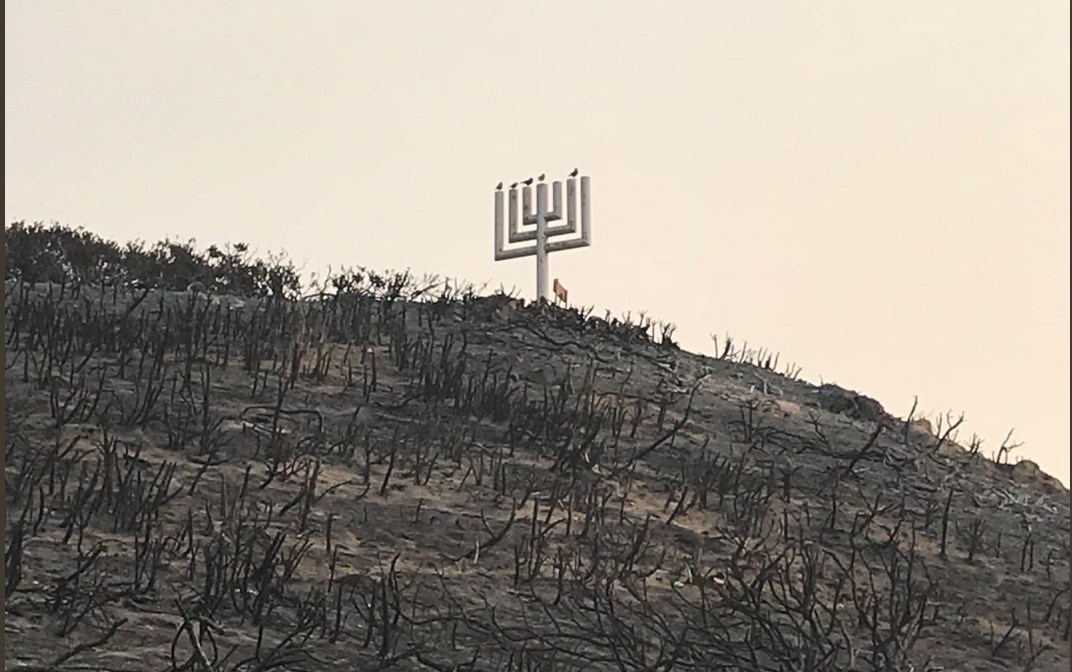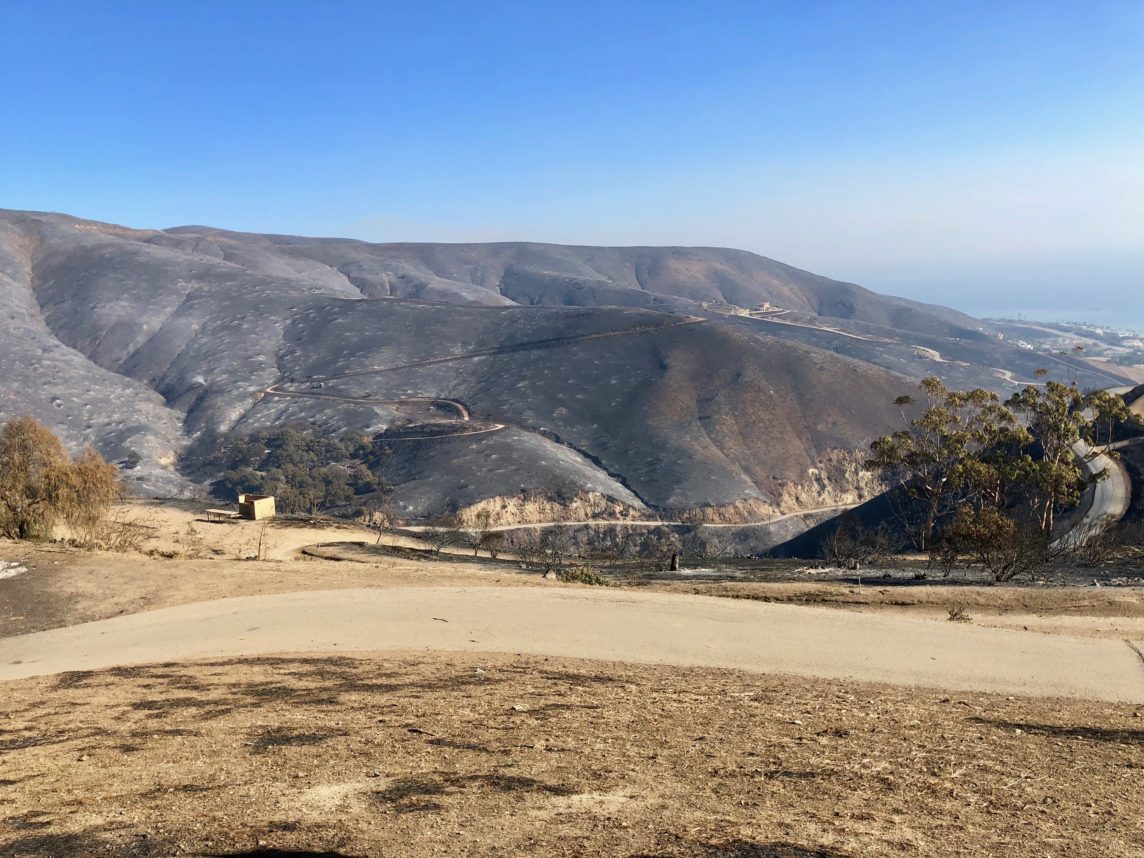 Remains of Camp Hess Kramer Photo by Ben Poston/ Los Angeles Times
Remains of Camp Hess Kramer Photo by Ben Poston/ Los Angeles Times The Jewish community has been reeling from the Woolsey wildfire in Malibu, Thousand Oaks and nearby areas, which destroyed much of Wilshire Boulevard Temple Camps, the Shalom Institute in Malibu and Ilan Ramon Day School in Agoura Hills.
Speaking with the Journal, Shalom Institute Executive Director Rabbi Bill Kaplan and Wilshire Boulevard Temple Senior Rabbi Steve Leder described the damage to their respective organizations as significant.
“There is only about half of the property [remaining],” Kaplan said. “It’s in pretty bad shape. Some buildings are completely gone.”
Among the buildings destroyed were the Emma Stern Center, which provides lodging for guests of the Jewish education center and camp, the Shalom Institute’s Shemesh Farm for special needs young adults, the changing room by the pool, the conference center, the barn, yurts and bridges to all the different areas.
“There’s a fireball that went through there,” said Kaplan, who had not been able to access the site as of Nov. 12. “There’s probably not much remaining.”
Wilshire Boulevard Temple’s Camp Hess Kramer and Gindling Hilltop Camp also suffered severe damage.
“Camp is a mindset, not necessarily a physical place. Knowing we have a loving, caring community that wants us to succeed is amazing, uplifting and inspiring. ” — Rabbi Bill Kaplan
“I can tell you that at the upper camp, everything except for two cinderblock staff housing units has been destroyed — that’s at Hilltop,” said Leder, who also has not been able to visit the camps. “And at Kramer, the conference center, most of the dining hall and two cabins survived. Everything else is gone and we don’t know the extent of smoke damage to surviving structures, so they may be uninhabitable.”
Leder said he was not surprised when he learned the fire, which began Nov. 8, had reached his Malibu camps. “Well, I expected it, to be honest, from the beginning. Fire has just barely missed our camps five times in the past. When I saw what was going on in Malibu, I fully expected a complete wipeout.”
Leder added that the most important thing is that everyone was safely evacuated and that the Torah scrolls were saved. “Now we are making sure our staff who lived on-site have places to live and know we will take care of them and their families,” he said.
Leder was attending a groundbreaking for a new structure at Wilshire Boulevard Temple’s Koreatown campus on Sunday when he heard the fire had reached his camps. He said he was struck by the juxtaposition of celebrating the beginning of a new structure at the synagogue and mourning the loss of old ones.
“We broke ground on the Rem Koolhaas[-designed] Audrey Irmas Pavilion, which I think will be maybe the most important piece of American-Jewish architecture of this century, at the same time we were learning we lost the camps,” he said. “My grandmother had this Yiddish expression: ‘God doesn’t give with both hands.’ I had that feeling, that sweet and sour part of life.”
The Woolsey fire began to blaze in the Simi Valley area the afternoon of Nov. 8 and by Nov. 12 had destroyed nearly 92,000 acres from West Hills to Malibu. As the flames approached the Shalom Institute, home of Camp JCA Shalom on Mulholland Highway, Kaplan’s focus was on evacuating staff living at the camp as well as the animals — horses, steer, donkeys and bunnies — there. Many of the animals were sheltered at the Ventura County Fairgrounds while Kaplan worked to find temporary homes for his staff.
“We are a family. We are kind of like ‘Kibbutz Shalom,’ ” he said. “It is a caring, loving community of people. It’s a loss of a facility and a loss of a culture. A work culture. That part is the most challenging. And not knowing what we’re expecting. But we’re figuring it out. Our team is great and we’re moving forward very quickly.”
Both Leder and Kaplan plan to hold their summer camps in 2019 at temporary locations and hope to rebuild their respective camps better than before.
“Camp is a mindset, not necessarily a physical place,” Kaplan said. “Knowing we have a loving, caring community that wants us to succeed is amazing, uplifting and inspiring. We are going to get through this.”
“We will end up with better camps as a result of this,” Leder said, “and that is not to dismiss the sadness of all of us who have memories of things that have happened there, in those buildings, but I’m reminding everyone the fire doesn’t destroy memories, Jews are good at rebuilding. That’s what we do.”
Jay Sanderson, CEO of The Jewish Federation of Greater Los Angeles, pledged Federation support for the camps. It has opened up its Valley Alliance office on Ventura Boulevard in Woodland Hills to organizations in need, including the Shalom Institute.
“And obviously, we’re working directly with the camps that are gone, working directly with Camp JCA Shalom and Wilshire Boulevard Temple,” Sanderson said. “To the credit of the management of the camps and the leadership of Wilshire Boulevard Temple and the Shalom Institute, there was no loss of life, either animal or human.”
Last Saturday night, much of the Wilshire Boulevard Temple camp community came together for a Havdalah service at the synagogue’s West L.A. campus. Los Angeles Mayor Eric Garcetti was among those who attended. And on Sunday, much of the Shalom Institute came together at de Toledo High School in West Hills for updates about the fire.
“There was lot of mourning going on, certainly around the loss of these camps,” said Sanderson, who was among those who spoke at de Toledo. “Everybody needs to be assured these camps will come back better and stronger. It’s a very sad thing to see a place you love so much burned to the ground.”
Update, Nov. 19: “Among the buildings and areas lost to the fire at Hess Kramer are Baruh Hall, Gildred Hall, the climbing wall, Leadership Library, the dance platform, and the ark, along with several staff residences and all but two of the cabins. At Hilltop, all structures were lost with the exception of two cinder block staff housing units,” according to the Wilshire Boulevard Temple website.



View photos of the destruction at the Shalom Institute as well as updates about the site here.
How to Help Victims:
The Jewish Federation of Los Angeles has launched a hotline for those affected by the fires. Support can be anything related to housing, food, legal questions, insurance questions or just someone to talk to you.
“If somebody belongs to a synagogue a rabbi has connection to them. If they don’t belong to synagogue we only hear from them if they let us know,” Federation CEO Jay Sanderson told the Journal. “It’s a wildfire emergency hotline. Someone will answer it between 8 a.m. and 8 p.m. seven days. As long as it is needed.”
Anyone who calls will speak to a staff member from the Federation. This includes members of the Jews in Need initiative who are trained in specific issues.
The non-profit also launched The Wildfire Relief Fund, where 100 percent of all money raised will go to victims of the fires and institutions that have received significant damage.
“We will be working with those institutions to help them raise additional funds, to help them with their planning go forward. Whatever they need we are going to help them,” Sanderson said.
To donate, visit www.jewishla.org. The hotline number is: (323) 761–8100.























 More news and opinions than at a Shabbat dinner, right in your inbox.
More news and opinions than at a Shabbat dinner, right in your inbox.